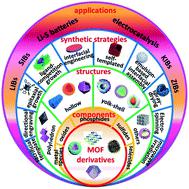当前位置:
X-MOL 学术
›
J. Mater. Chem. A
›
论文详情
Our official English website, www.x-mol.net, welcomes your feedback! (Note: you will need to create a separate account there.)
Advances and challenges in metal–organic framework derived porous materials for batteries and electrocatalysis
Journal of Materials Chemistry A ( IF 11.9 ) Pub Date : 2020-11-04 , DOI: 10.1039/d0ta08311a Liqin Wang 1, 2, 3, 4, 5 , Youqi Zhu 1, 2, 3, 4, 5 , Changliang Du 1, 2, 3, 4, 5 , Xilan Ma 1, 2, 3, 4, 5 , Chuanbao Cao 1, 2, 3, 4, 5
Journal of Materials Chemistry A ( IF 11.9 ) Pub Date : 2020-11-04 , DOI: 10.1039/d0ta08311a Liqin Wang 1, 2, 3, 4, 5 , Youqi Zhu 1, 2, 3, 4, 5 , Changliang Du 1, 2, 3, 4, 5 , Xilan Ma 1, 2, 3, 4, 5 , Chuanbao Cao 1, 2, 3, 4, 5
Affiliation

|
The development of advanced functional materials is of great significance for applications in energy storage and conversion fields. Metal–organic framework (MOF) derived porous materials have attracted extensive attention due to their high porosity, complex components and controllable structures. Although considerable achievements have been made in the controllable synthesis of multifunctional MOF derivatives, their systematic synthesis and applications in new-style energy storage and conversion devices (e.g. sodium ion batteries, potassium ion batteries, zinc ion batteries and fuel cells) have rarely been reviewed in depth. Given that materials' structures are highly dependent on the particular synthetic strategy and determine the final physical and chemical performances, a comprehensive insight into the latest advances in complex MOF-derived porous materials is provided in this review. The versatile architectures of functional materials and their influences on properties are clearly summarized. The advantages of the MOF-derived route over traditional non-MOF methods are highlighted. In the end, the challenges and the prospective research direction of MOF-derived functional materials in energy storage and conversion fields are proposed. The strategy–structure–property relationships in this review will provide scientific evidence on the reasonable design of high-efficiency MOF-derived functional materials for new energy systems.
中文翻译:

金属-有机骨架衍生的用于电池和电催化的多孔材料的进展与挑战
先进功能材料的开发对于储能和转换领域的应用具有重要意义。金属有机骨架(MOF)衍生的多孔材料由于其高孔隙率,复杂的组件和可控的结构而引起了广泛的关注。尽管在多功能MOF衍生物的可控合成中已经取得了可观的成就,但它们的系统合成及其在新型储能和转换装置中的应用(例如钠离子电池,钾离子电池,锌离子电池和燃料电池)很少得到深入的审查。鉴于材料的结构高度依赖于特定的合成策略并确定最终的物理和化学性能,本综述提供了对复杂的MOF衍生多孔材料最新进展的全面了解。功能材料的通用体系结构及其对性能的影响已得到清晰总结。与传统的非MOF方法相比,MOF派生的路由的优势得到了强调。最后,提出了MOF衍生功能材料在储能和转化领域的挑战和未来的研究方向。
更新日期:2020-11-21
中文翻译:

金属-有机骨架衍生的用于电池和电催化的多孔材料的进展与挑战
先进功能材料的开发对于储能和转换领域的应用具有重要意义。金属有机骨架(MOF)衍生的多孔材料由于其高孔隙率,复杂的组件和可控的结构而引起了广泛的关注。尽管在多功能MOF衍生物的可控合成中已经取得了可观的成就,但它们的系统合成及其在新型储能和转换装置中的应用(例如钠离子电池,钾离子电池,锌离子电池和燃料电池)很少得到深入的审查。鉴于材料的结构高度依赖于特定的合成策略并确定最终的物理和化学性能,本综述提供了对复杂的MOF衍生多孔材料最新进展的全面了解。功能材料的通用体系结构及其对性能的影响已得到清晰总结。与传统的非MOF方法相比,MOF派生的路由的优势得到了强调。最后,提出了MOF衍生功能材料在储能和转化领域的挑战和未来的研究方向。



























 京公网安备 11010802027423号
京公网安备 11010802027423号